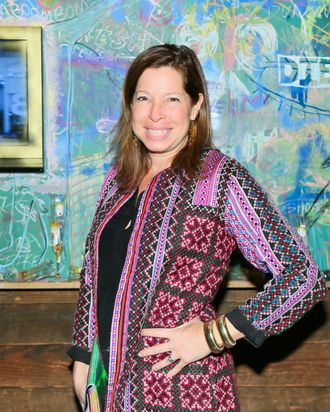
Good things come in twos when it comes to promising news in New York museums. Only two weeks after the enchanted opening of the made-for-art, made-for-artists Whitney Museum, the Brooklyn Museum has announced that its new director will be Anne Pasternak. This is spellbinding news for those in the art world. Long known for her unflagging commitment to art, artists, and activism as the dynamic director since 1994 of Creative Time ÔÇö the not-for-profit powerhouse that brought us Kara WalkerÔÇÖs sugar sphinx last year, among many other spectacular projects ÔÇö with this appointment Pasternak becomes the first woman to lead one of the very large encyclopedic New York art museums. (Thelma Golden, Holly Block, and Claudia Gould, of course, are doing bang-up work at the Studio Museum of Harlem, the Bronx Museum, and the Jewish Museum, respectively. And Laura Raicovich just took over the Queens Museum.)
Pasternak is the perfect choice. SheÔÇÖs a dynamo who puts off ÔÇ£I love thisÔÇØ energy, is always first in the trenches, sees everything, has always remained close to artists, is able to raise money, takes meetings, and isnÔÇÖt averse to staying up late and dancing in public, sometimes with her daughter. She will follow in the creative footsteps of Arnold Lehman, who over the last 17 years has opened the museum to a much larger, far more diverse audience, and proved that this could be done without sacrificing quality of programming. Under Lehman, the museum proved that it could be experimental and political while also doing worthy shows; in the last three seasons, the museum has presented solos of Jean-Michel Basquiat, Kehinde Wiley, Swoon, Wangechi Mutu, LaToya Ruby Frazier, and Mickalene Thomas.
The Pasternak fit as LehmanÔÇÖs successor is so perfect that the day I heard last September that Lehman was stepping down, I was at an opening in Bushwick. When I spotted Pasternak, I had a vision of her as the museumÔÇÖs next director. I walked over and told her so.
The vision was and wasnÔÇÖt a stretch. Pasternak is not cut from the academic or managerial cloth of most museum directors. As near as I can determine, she only has a bachelorÔÇÖs in art history. (Though, perhaps suddenly sensitive to charges from academia that she lacks gravitas or nervous about the upper-echelon museum world viewing her as undereducated and unqualified for this world-class executive position, she now touchingly lists an honorary PhD from Hunter on her r├®sum├®.) And many in the art world have long disdained the idea that a museum director should be tainted by being a gallerist. As a four-year former director of Stux Gallery in New York, notwithstanding Jeffrey DeitchÔÇÖs L.A. MoCA abbreviated tenure, Pasternak joins Hammer director Anne Philbin and others as one who comes from this so-called bad ÔÇ£market typeÔÇØ side of the tracks.
But Pasternak doesnÔÇÖt need to prove her credentials to anyone in the art world. SheÔÇÖs commissioned artworks in every borough, outdoors, indoors, at Grand CentralÔÇÖs Vanderbilt Hall, inside the Brooklyn Anchorage, on Governors Island, on streets and storefronts. In addition to sponsoring talks, lectures, and ÔÇ£summitsÔÇØ about art and politics, billboards by Felix Gonz├ílez-Torres, David ByrneÔÇÖs mad-player piano in an abandoned downtown ferry building, huge installations in a now-razed Delancey Street building, and numerous other projects on the Times Square Jumbotron, she sponsored the 2006 show ÔÇ£Strange Powers,ÔÇØ curated by Laura Hoptman and Peter Eleey, both of whom are now MoMA curators. SheÔÇÖs got a nose for news and an eye for talent. Pasternak steps into a museum ready to go to the next level.
There is a big downside to the Brooklyn Museum, which must be wholly and realistically addressed under Pasternak, and she cannot downplay or be defensive about the issue because the problem is severe and bringing down every aspect of this great museum. The installation of many parts of this museumÔÇÖs tremendous permanent collection borders on the horrendous. Many galleries are arranged willy-nilly, crammed into divided overdesigned spaces, accompanied sometimes by piped-in music, installed on crazily colored walls, organized by themes, or in other bewildering ways. All of this generally dumbs down this great encyclopedic collection to near incomprehensibility and makes visiting these wings and arrangements depressing. None of this is a mark against Lehman, who succeeded on so many levels, including bringing down the average age of Brooklyn MuseumÔÇôgoers from 58 to 35. That and the openness of his contemporary programming are extraordinary achievements. PasternakÔÇÖs obvious strong point will be around contemporary art. But to be a great museum director and a great director of this museum, she must make an extra effort not to let down this collection. Not to spare feelings. To act decisively. To save it. She can now school this audience to artÔÇÖs real powers.
She has something on her side that makes failure unforgivable. A hidden superpower of the Brooklyn Museum is how much space it has; beautiful Beaux Arts space, weirdly Modernist space, weirder postmodern space, nooks and alcoves that could become galleries. All that and more outdoor space for public commissions than probably any museum on the East Coast. All of it, if put in the service of art and this great collection, could establish the Brooklyn Museum as one of the finest, most indispensable museums in America. What could happen with early 20th century and African art alone is breathtaking and could be the envy of any other museum.
Change has come to the Whitney Museum. With the appointment of Pasternak, the Brooklyn Museum is now looking at a future as bright or even brighter, by virtue of the enormity of the space and the untapped potential at its disposal. If Pasternak is fearless, makes hard choices, and acts with the collection and art in mind at all times, she could make miracles here. Not to do so would unnecessarily doom this museum for a generation.

